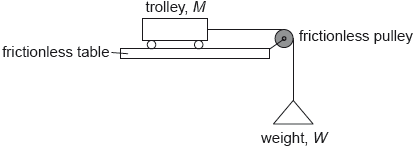| Date | May 2022 | Marks available | 3 | Reference code | 22M.2.SL.TZ1.1 |
| Level | Standard level | Paper | Paper 2 | Time zone | 1 |
| Command term | Explain | Question number | 1 | Adapted from | N/A |
Question
A student uses a load to pull a box up a ramp inclined at 30°. A string of constant length and negligible mass connects the box to the load that falls vertically. The string passes over a pulley that runs on a frictionless axle. Friction acts between the base of the box and the ramp. Air resistance is negligible.
The load has a mass of 3.5 kg and is initially 0.95 m above the floor. The mass of the box is 1.5 kg.
The load is released and accelerates downwards.
Outline two differences between the momentum of the box and the momentum of the load at the same instant.
The vertical acceleration of the load downwards is 2.4 m s−2.
Calculate the tension in the string.
Show that the speed of the load when it hits the floor is about 2.1 m s−1.
The radius of the pulley is 2.5 cm. Calculate the angular speed of rotation of the pulley as the load hits the floor. State your answer to an appropriate number of significant figures.
After the load has hit the floor, the box travels a further 0.35 m along the ramp before coming to rest. Determine the average frictional force between the box and the surface of the ramp.
The student then makes the ramp horizontal and applies a constant horizontal force to the box. The force is just large enough to start the box moving. The force continues to be applied after the box begins to move.
Explain, with reference to the frictional force acting, why the box accelerates once it has started to move.
Markscheme
direction of motion is different / OWTTE ✓
mv / magnitude of momentum is different «even though v the same» ✓
use of ma = mg − T «3.5 x 2.4 = 3.5g − T »
OR
T = 3.5(g − 2.4) ✓
26 «N» ✓
Accept 27 N from g = 10 m s−2
proper use of kinematic equation ✓
«m s−1» ✓
Must see either the substituted values OR a value for v to at least three s.f. for MP2.
use of to give 84 «rad s−1»
OR
to give 84 «rad s−1» ✓
quoted to 2sf only✓
ALTERNATIVE 1
«» leading to a = 6.3 «m s-2»
OR
« » leading to t = 0.33 « s » ✓
Fnet = « = » 9.45 «N» ✓
Weight down ramp = 1.5 x 9.8 x sin(30) = 7.4 «N» ✓
friction force = net force – weight down ramp = 2.1 «N» ✓
ALTERNATIVE 2
kinetic energy initial = work done to stop 0.5 x 1.5 x (2.1)2 = FNET x 0.35 ✓
Fnet = 9.45 «N» ✓
Weight down ramp = 1.5 x 9.8 x sin(30) = 7.4 «N» ✓
friction force = net force – weight down ramp = 2.1 «N» ✓
Accept 1.95 N from g = 10 m s-2.
Accept 2.42 N from u = 2.14 m s-1.
static coefficient of friction > dynamic/kinetic coefficient of friction / μs > μk ✓
«therefore» force of dynamic/kinetic friction will be less than the force of static friction ✓
there will be a net / unbalanced forward force once in motion «which results in acceleration»
OR
reference to net F = ma ✓
Examiners report
Many students recognized the vector nature of momentum implied in the question, although some focused on the forces acting on each object rather than discussing the momentum.
Some students simply calculated the net force acting on the load and did not recognize that this was not the tension force. Many set up a net force equation but had the direction of the forces backwards. This generally resulted from sloppy problem solving.
This was a "show that" questions, so examiners were looking for a clear equation leading to a clear substitution of values leading to an answer that had more significant digits than the given answer. Most candidates successfully selected the correct equation and showed a proper substitution. Some candidates started with an energy approach that needed modification as it clearly led to an incorrect solution. These responses did not receive full marks.
This SL only question was generally well done. Despite some power of 10 errors, many candidates correctly reported final answer to 2 sf.
Candidates struggled with this question. Very few drew a clear free-body diagram and many simply calculated the acceleration of the box from the given information and used this to calculate the net force on the box, confusing this with the frictional force.
This was an "explain" question, so examiners were looking for a clear line of discussion starting with a comparison of the coefficients of friction, leading to a comparison of the relative magnitudes of the forces of friction and ultimately the rise of a net force leading to an acceleration. Many candidates recognized that this was a question about the comparison between static and kinetic/dynamic friction but did not clearly specify which they were referring to in their responses. Some candidates clearly did not read the stem carefully as they referred to the mass being on an incline.


